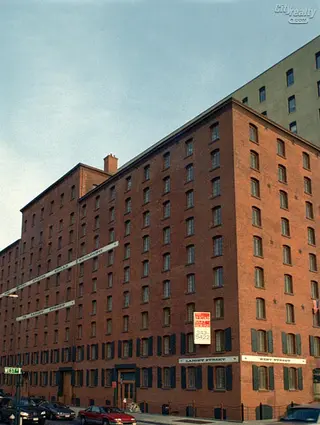 Carter Horsley
Carter HorsleyDec 23, 2011
Carter's Review
The Sugar Warehouse at 79 Laight Street on the southwest corner of West Street in TriBeCa was built in 1853 by the Grocers Steam Sugar Refining Company and later sold to the United States Sugar Refining Company.
According to Joseph Pell Lombardi, the architect involved in this impressive project's 2002 restoration and conversion to condominium apartments, this 10-story building was one of the tallest in the city when it was built. In a March 15, 2002 article by Nadine Brozan in The New York Times, Mr. Lombardi, one of the city’s most active converters, was quoted as saying "It was tall and proud on the skyline, one of our more important buildings."
The 10-story building has 34 apartments.
It was acquired in 2000 by Alex Forkosh of Forkosh Construction and Mr. Lombardi noted that its conversion was "one of the more complex" he had ever done because its core was 10 stories tall but other parts were five or six stories.
"All the Landmarks Preservation Commission requirements were things we wanted to do anyway, like restoring the shutters and bricks and repainting the sign and street names on the sides," Mr. Lombardi was quoted in The Times article.
Bottom Line
One of the major conversion projects in TriBeCa, the Sugar Building has great charm because of its black window shutters and lengthy red-brick façade that extends to West Street.
Description
The ambience created by the black metal window shutters on the lower two floors and the emblazoning in paint of the building's name and address in white paint on the red-brick façades is very charming.
Some of the apartments have 15-foot-high ceilings and two interior courts were created to bring light into the building.
Most of the apartments are split-levels and several of the penthouses have skylights. All the apartments have two to three bedrooms.
The building has a three-step-up entrance and a dry moat and concierge but no sidewalk landscaping and no garage.
The building’s windows are slightly arched and an entirely new structural system was installed behind the façade to create split-level units.
Amenities
The building has a roof deck, a fitness center, a bicycle room, a nursery and private storage. The building has a live-in superintendent and is pet friendly.
Apartments
Apartment 1D has an entry foyer that leads past two bedrooms to a 13-foot-long office to a 16-foot-long dining room next to a 15-foot-long open kitchen off the 22-foot-living room.
Apartment 1C is a duplex unit with a entry foyer that leads to a 19-foot-long open kitchen and a 24-foot-long living room and two bedrooms on the lower level and three bedroom as and a very large dining area with large kitchen on the upper level.
Apartment 3D is a three-bedroom duplex with a 30-foot-long living room, a 13-foot-long den, a 16-foot-long kitchen and an 18-foot-long bedroom on the first floor and a 13-foot-long hallway with a 14-foot-long study and two bedrooms, one with a small alcove, on the upper level.
Apartment 4C is a two-bedroom duplex unit with a 10-foot-long entry hall leading to a 19-foot-long dining room next to an angled, open 14-foot-wide kitchen and up three steps to a 30-foot-wide living room on the lower level and two bedrooms, one with an alcove, and a 20-foot-long library on the upper level.
Apartment 5B has a 35-foot-long living/dining room with a 110-foot-long open kitchen on the lower level and three bedrooms on the upper level.
Penthouse 5C has a 27-foot-square living room with an 11-foot-long open kitchen.
A triplex penthouse unit has a 28-foot-long living room with wood-burning fireplace and a 11-foot-long open kitchen on the lower level, two bedrooms on the middle level and an “all glass” 25-foot-long studio on the top level.
History
After the Civil War, much of the city's important shipping activity switched from the East River to the Hudson River where longer piers could accommodate bigger ships and many warehouses were erected and used to create what became known as the Washington Market, which specialized in mostly in produce.
Eventually the Washington Market was relocated to a city facility in the Hunts Point section of the Bronx and much of the area became known as TriBeCa (Triangle Below Canal).
Landfill from the recently completed World Trade Center, of course, was used to enlarge Manhattan's Hudson River waterfront with Battery Park City and TriBeCa quickly becoming popular for artists as prices in SoHo had begun to soar.
The combination of older not fully filled buildings with trendy restaurants gradually led to numerous residential conversions, a trend that took off with quite incredible momentum after the tragic incidents of September 11, 2001 and quickly made TriBeCa the city's hottest real estate market.
One of the most impressive projects at this time was this building, which was next to a sugar refinery that Mr. Lombardi said at some point suffered from a "catastrophe" that required the removal of every other floor.
It is across Laight Street from the River Lofts project that is a combination of the residential conversion of a red-brick warehouse and the new construction of a red-brick condominium apartment building along West Street.

- Condo built in 1853
- Converted in 2002
- 2 apartments currently for sale ($3.495M to $4.495M)
- 1 apartment currently for rent ($29K)
- Located in Tribeca
- 34 total apartments 34 total apartments
- 10 recent sales ($3M to $6.7M)
- Doorman

 6sqft delivers the latest on real estate, architecture, and design, straight from New York City.
6sqft delivers the latest on real estate, architecture, and design, straight from New York City.
